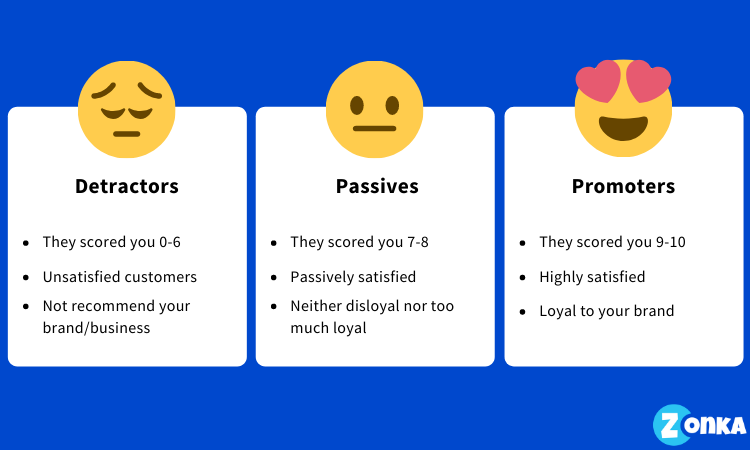You have spent months building your brand, promoting your product, and your customer flow certainly reflects all that hard work you put in. One of the many things businesses look over is the rate of return of their customers. Many things can make a customer either come back to your brand or avoid it like the plague.
Measure Customer Loyalty with NPS ❤️
Create NPS surveys, measure customer loyalty, and close the feedback loop with Zonka Feedback.

So how is a business able to keep these personal ratings in check? By implementing a customer feedback system and measure the Net Promoter Score (NPS) using the NPS Survey.
What is Net Promoter Score?
NPS stands for Net Promoter Score or Net Promoter System; all it implies is a single question that provides an incredible amount of feedback to a company. The magic question is “How likely is it that you would recommend our company/product/service to a friend or colleague?” When doing a survey, this question is frequently answered on a 0-10 scale. With this information, you can see which customers are going to be committed to your brand, and those who you need to work with more.
Understanding Net Promoter Score
Understanding the scale of a Net Promoter Score is pretty straightforward once you understand the three main concepts it conveys.

Detractors
They are the customers who answered below or equal to 6. They were not entirely satisfied with their experience and would probably tarnish your brand’s reputation with negative word-of-mouth. It would be highly unlikely that they would even return as customers again.
Passives
They are the customers who have answered the question with from 7 to 8. They probably had a good experience with your brand, but not so convinced with your service offering that they would go out of their way to recommend your brand among their social circle. They could be loyal to your business, but quickly switch to a competitor if needed.
Promoters
The customers who answered the question with a 9 or a 10. They are the customers who loved your product or service offering and are most likely recommend your brand to their friends and family. They are your most loyal customers and would look forward to repeating business with you.
The Net Promoter Score is then calculated by subtracting the percentage of detractors from the percentage of promoters. Theoretically, it can range from -100 to +100. Practically, it is most likely to hover around 15 for most businesses in a competitive space. An NPS above 40, in fact, is considered exceedingly rare and is regarded as the benchmark for top players of any industry. This feedback system is a critical application in most businesses, restaurants, and hotels. Learn to calculate the Net Promoter Score of your business.
Pros of Net Promoter Score
But why should your business rely on such a simple method? Here are a few of the reason we trust an NPS.
- It is an industry-recognized metric that was incorporated by the leading management-consulting firm Bain & Company, so any business manager using it can be confident of its credibility.
- It results in an easy-to-read number that can tell at a glance what percentage of the customer base is extremely satisfied with the service and performance. In essence, it gives the customer relationship manager an insight into their overall performance of customer retention and acquisition with just a single question.
- Using an industry-recognized numeric can help companies identify their position in the competitive landscape and established players can use their high NPS to set a benchmark in the industry.
- It is easy to implement and interpret, with results from day one. It is a simple out-of-the-box package that requires no experts to set up or analyze.
- Research has shown that NPS correlates strongly with a company’s revenue, so implementing this system in a business can motivate employees to strive for better customer service, and hence a higher NPS.
- By tracking the trend of NPS over time, a company can use this as a sneaker proxies for measuring its growth and maturity. A start-up is not well known and will probably have a low NPS while an established player will have a high NPS.
Cons of Net Promoter Score
However, it needs to be mentioned that with NPS, there is more than meets the eye. It comes with inherent drawbacks that need to be mentioned:
- It is indeed difficult to quantify a customer’s loyalty, which is what the NPS attempts.
- The question asks the customers their “likelihood” to recommend the brand or service, and business managers must be mindful of this word. In no way does it guarantee that a customer giving a score of 10 will most certainly go ahead and 'promote' the business.
- There is some debate regarding the statistical validity of collapsing an 11-point scale into three components, as it may lead to loss of information in the middle ranges. The statistical assumption of classifying a customer as “detractor” if he gives a score of 6 or less, and a “promoter” if he gives a score of 9 or 10 has been challenged.
- There is still dissent over the efficiency of NPS across industries. What is regarded as a good NPS in one industry may not serve as a good measure of customer loyalty in another industry. The NPS would serve its intended purpose much better if accompanied with a detailed questionnaire that seeks to measure customer loyalty across all parameters of service and at all points of contact with the customer.
3 Things to Keep in Mind While Adopting NPS for Your Business
Well measuring the NPS is as easy as it can get. But the trick lies in understanding what it means for your business. There are three things that every business manager must keep in mind when adopting the NPS:
- NPS is only an indicative measure of a customer’s loyalty, not their overall satisfaction with the company’s product or service. Hence, it must be accompanied with a full-fledged customer feedback survey to gauge their satisfaction level that can be analyzed in depth to ascertain the reason behind a company’s high or low NPS and take corrective actions.
- The NPS by itself would mean nothing if not implemented with an ambition to increase it over time. This would require dedicated commitment from the company’s management to make the company more customer-centric.
- It is imperative to close the feedback loop. If you take a customer's feedback, it is important to act on it and communicate with the customer. Implementing Net Promoter System must be hand-in-hand with the implementation of a system that enables businesses to capture Voice of Customer and Take Actions.
By taking the decision to implementing an NPS program, a business has taken the decision to improve its customer’s loyalty and increase customer retention, along with a new source of advertising. But it is important to go through with the decision in a well planned system that ensures that the program is a complete success.

 MS Teams
MS Teams














